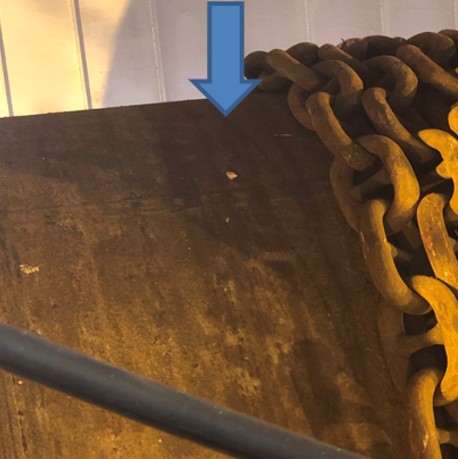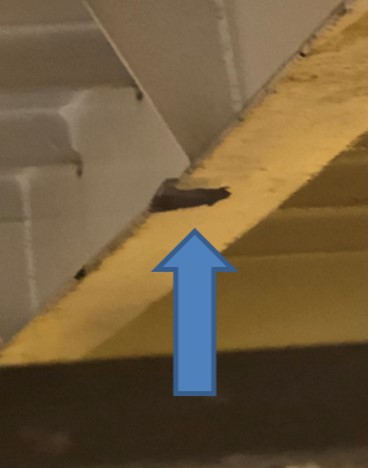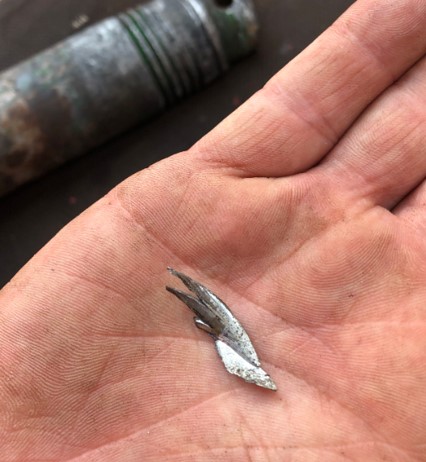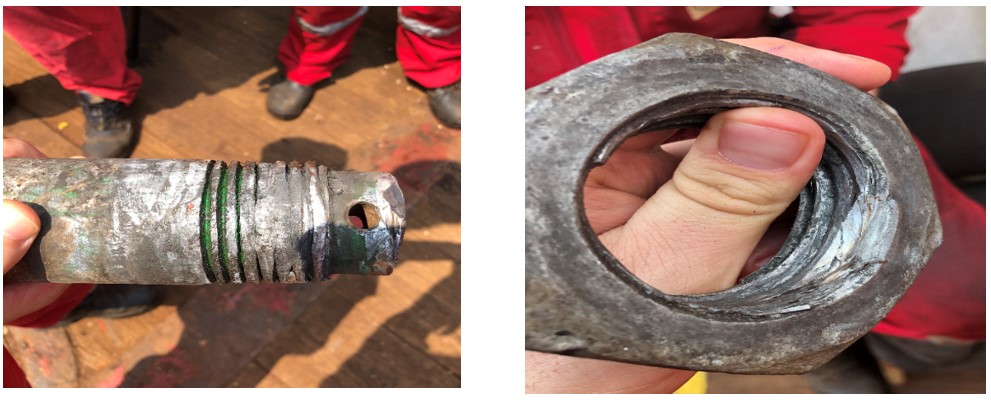Shackle failure during over-boarding of pennant wire and ballast chain
What happened
During over-boarding of the pennant wire and ballast chain from the main anchor handling winch over the stern roller, there was a failure in the chain link / 35t shackle. The failure occurred and the damaged chain came off the winch, went across the main deck and over the stern of the vessel. Everyone was in a safe position, and no-one was harmed, but there was damage to other nearby winch equipment. 110m of chain were lost overboard; our member calculated that this meant there was approximately 31.7t (submerged weight) of tension on the chain at the time of the incident.

Breaking point location of shackle on drum


What went wrong?
- Evidence suggested that during the over-boarding of the chain, the nut on the shackle pin became lodged behind the stud piece of the chain link whilst wrapped on the winch drum.
- When tension was applied on this section of the chain the links straightened and caused the nut of the shackle to be forced off along with the stud piece.
- The resultant shock may have then forced the pin out of the shackle and allowed the chain to part;
- At the point of shackle failure, the chain on the winch drum become loose and whipped towards the special handing winch causing multiple impact damage to surrounding equipment;
What was the cause?
- Immediate causes
- Connection of different chain link sections using shackles and spooling them off the stern of the vessel for wet storage;
- The decision to wet store the ballast chain was made onboard and not covered in the original project planning or HIRA.
- Underlying causes
- No inspection certificates available for the 82mm chain;
- Poor maintenance of the 82mm chain due to the fact it was only to be used as ballast weight in single 27.5m sections;
- Kenter joining links were not used to connect the section of 82mm chain together, they were ordered but did not arrive;
- Internal signed management of change documentation was missing some important detail regarding the actual connection of the individual chains to be wet stored;
- The chain was connected with 35t shackles which have multiple edges that can be caught or trapped inside other equipment, especially the nuts.
Our member concluded that that the assessment of risk of connecting the chains using the shackles was overlooked mainly due to last minute change in the engineering planning of this scope of the project (IMCA italics).

Members may wish to refer to:
Safety Event
Published: 18 November 2021
Download: IMCA SF 31/21
IMCA Safety Flashes
Submit a Report
IMCA Safety Flashes summarise key safety matters and incidents, allowing lessons to be more easily learnt for the benefit of all. The effectiveness of the IMCA Safety Flash system depends on Members sharing information and so avoiding repeat incidents. Please consider adding [email protected] to your internal distribution list for safety alerts or manually submitting information on incidents you consider may be relevant. All information is anonymised or sanitised, as appropriate.
IMCA’s store terms and conditions (https://www.imca-int.com/legal-notices/terms/) apply to all downloads from IMCA’s website, including this document.
IMCA makes every effort to ensure the accuracy and reliability of the data contained in the documents it publishes, but IMCA shall not be liable for any guidance and/or recommendation and/or statement herein contained. The information contained in this document does not fulfil or replace any individual’s or Member's legal, regulatory or other duties or obligations in respect of their operations. Individuals and Members remain solely responsible for the safe, lawful and proper conduct of their operations.
